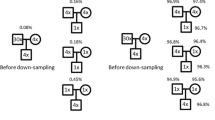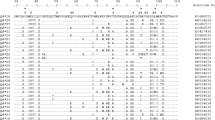Abstract
Genetic heterogeneity of the population used in the experimental studies with living organisms as model objects is one of the reasons for the poor replicability of the results. Nonhuman primates represent the phylogenetically closest model to humans and it is possible to use it in the studies of genetic basis of diseases with a hereditary predisposition. However, primates represent a population that is significantly limited in number when kept in captivity. We have studied the genetic homogeneity of the population of male rhesus macaques by polymorphisms of genes oprm1, npy, maoa, crh, and 5-htt. Cluster analysis (method of K-means) was used for the assessment considering data of genotyping, origination of the animals, blood count, and veterinary examination. Two significant clusters of animals were identified which differ in the values of blood count parameters within the reference range. The identified clusters are not associated with the origin, age, housing conditions, and the level of morbidity of animals. Clustering made it possible to identify a subpopulation of animals with frequency of carriers of maoa gene VNTR polymorphism with seven repeats 25% higher compared to the entire population. Thus, cluster analysis of nongenetic data may be of use to assess the homogeneity of the distribution of genetic variants in a population and to select a genetically more homogeneous subpopulation in order to reduce the problem of small samples in biomedical research.


Similar content being viewed by others
REFERENCES
National Academies of Sciences, Engineering, and Medicine, et al., Reproducibility and Replicability in Science, Washington, DC: The National Academies Press, 2019. https://doi.org/10.17226/25303.
Ledolter, J. and Kardon, R.H., Focus on data: statistical design of experiments and sample size selection using power analysis, Invest. Ophthalmol. Vis. Sci., 2020, vol. 61, pp. 11. https://doi.org/10.1167/iovs.61.8.11
Vijayarani, S. and Sudha, S., An efficient clustering algorithm for predicting diseases from hemogram blood test samples, Ind. J. Sci. Technol., 2015, vol. 8, pp. 1—8. https://doi.org/10.17485/ijst/2015/v8i17/52123
Phifer-Rixey, M. and Nachman, M.W., Insights into mammalian biology from the wild house mouse Mus musculus, eLife, 2015, vol. 4. e05959. https://doi.org/10.7554/eLife.05959
Homburger, J.R., Neben, C.L., Mishne, G., et al., Low coverage whole genome sequencing enables accurate assessment of common variants and calculation of genome-wide polygenic scores, bioRxiv, 2019, vol. 11, p. 74. https://doi.org/10.1186/s13073-019-0682-2
Komaru, Y., Yoshida, T., Hamasaki, Y., et al., Hierarchical clustering analysis for predicting 1-year mortality after starting hemodialysis, Kidney Int. Rep., 2020, vol. 5, pp. 1188—1195. https://doi.org/10.1016/j.ekir.2020.05.007
Nnoaham, K.E. and Cann, K.F., Can cluster analyses of linked healthcare data identify unique population segments in a general practice-registered population?, BMC Publ. Health, 2020, vol. 20, p. 798. https://doi.org/10.1186/s12889-020-08930-z
Barr, C.S., Schwandt, M., Lindell, S.G., et al., Association of a functional polymorphism in the µ-opioid receptor gene with alcohol response and consumption in male rhesus macaques, Arch. Gen. Psychiatry, 2007, vol. 64, no. 3, pp. 369—376. https://doi.org/10.1001/archpsyc.64.3.369
Lindell, S.G., Schwandt, M.L., Sun, H., et al., Functional NPY variation as a factor in stress resilience and alcohol consumption in rhesus macaques, Arch. Gen. Psychiatry, 2010, vol. 67, no. 4, pp. 423—431. https://doi.org/10.1001/archgenpsychiatry.2010.23
Barr, C.S., Schwandt, M.L., Newman, T.K., and Higley, J.D., The use of adolescent nonhuman primates to model human alcohol intake: neurobiological, genetic, and psychological variables, Ann. N.Y. Acad. Sci., 2004, vol. 1021, pp. 221—233. https://doi.org/10.1196/annals.1308.027
Barr, C.S., Dvoskin, R.L., Gupte, M., et al., Functional crh variation increases stress-induced alcohol consumption in primates, Proc. Natl. Acad. Sci. U.S.A., 2009, vol. 106, pp. 14593—14598. https://doi.org/10.1073/pnas.0902863106
Barr, C.S., Newman, T.K., Lindell, S., et al., Interaction between serotonin transporter gene variation and rearing condition in alcohol preference and consumption in female primates, Arch. Gen. Psychiatry, 2004, vol. 61, pp. 1146—1152. https://doi.org/10.1001/archpsyc.61.11.1146
Agumava, A.A., Chikobava, M.G., and Lapin, B.A., Development of PCR test system for detecting primate betaherpes virinae, Mol. Genet., Microbiol. Virol., 2010, vol. 25, pp. 132—135. https://doi.org/10.3103/S0891416810030079
Miyabe-Nishiwaki, T., MacIntosh, A.J.J., Kaneko, A., et al., Hematological and blood chemistry values in captive Japanese macaques (Macaca fuscata fuscata), J. Med. Primatol., 2019, vol. 4, pp. 338—350. https://doi.org/10.1111/jmp.12434
Koo, B.-S., Lee, D.-H., Kang, P., et al., Reference values of hematological and biochemical parameters in young-adult cynomolgus monkey (Macaca fascicularis) and rhesus monkey (Macaca mulatta) anesthetized with ketamine hydrochloride, Lab. Anim. Res., 2019, vol. 35, no. 7. https://doi.org/10.5607/en20040
Ichihara, K., Statistical considerations for harmonization of the global multicenter study on reference values, Clin. Chim. Acta, 2014, vol. 432, pp. 108—118. https://doi.org/10.1016/j.cca.2014.01.025
Omuse, G., Maina, D., Mwangi, J., et al., Complete blood count reference intervals from a healthy adult urban population in Kenya, PLoS One, 2018, vol. 13. e0198444. https://doi.org/10.1371/journal.pone.0198444
Evans, D.M., Frazer, I.H., and Martin, N.G., Genetic and environmental causes of variation in basal levels of blood cells, Twin Res., 1999, vol. 2, pp. 250—257. https://doi.org/10.1375/136905299320565735
Okada, Y. and Kamatani, Y., Common genetic factors for hematological traits in humans, J. Hum. Genet., 2012, vol. 57, pp. 161—169. https://doi.org/10.1038/jhg.2012.2
Dragovich, A.Y. and Borinskaya, S.A., Genetic and genomic basis of aggressive behavior, Russ. J. Genet., 2019, vol. 55, no. 12, pp. 1445—1459. https://doi.org/10.1134/S1022795419090059
Brummett, B.H., Krystal, A.D., Siegler, I.C., et al., Associations of a regulatory polymorphism of monoamine oxidase-A gene promoter (MAOA-uVNTR) with symptoms of depression and sleep quality, Psychosomatic Med., 2007, vol. 69, pp. 396—401. https://doi.org/10.1097/PSY.0b013e31806d040b
Fischer, M.C., Rellstab, C., Leuzinger, M., et al., Estimating genomic diversity and population differentiation—an empirical comparison of microsatellite and SNP variation in Arabidopsis halleri, BMC Genomics, 2017, vol. 18, no. 69. https://doi.org/10.1186/s12864-016-3459-7
Funding
This work was carried out within the framework of the state assignment of the Research Institute of Medical Primatology for 2019–2021.
Author information
Authors and Affiliations
Corresponding author
Ethics declarations
Conflict of interest. The authors declare that they have no conflicts of interest.
Statement on the welfare of animals. All applicable international, national, and/or institutional guidelines for animal care and use have been followed.
Rights and permissions
About this article
Cite this article
Pavlova, L.E., Panchenko, A.V., Timina, M.F. et al. Genetic Homogeneity of the Population of Male Rhesus Macaques by the Polymorphisms of Genes oprm1, npy, maoa, crh, 5-htt as Determined by Cluster Analysis of Blood Count Data. Russ J Genet 58, 420–427 (2022). https://doi.org/10.1134/S1022795422030097
Received:
Revised:
Accepted:
Published:
Issue Date:
DOI: https://doi.org/10.1134/S1022795422030097




